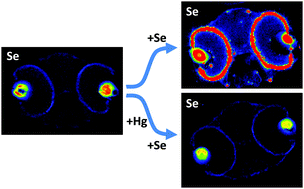Disruption of selenium transport and function is a major contributor to mercury toxicity in zebrafish larvae†
Abstract
Mercury is one of the most toxic elements threatening the biosphere, with levels steadily rising due to both natural and human activities. Selenium is an essential micronutrient, required for normal development and functioning of many organisms. While selenium is known to counteract mercury's toxicity under some conditions, to date information about the mercury-selenium relationship is fragmented and often controversial. As part of a systematic study of mercury and selenium interactions, zebrafish (Danio rerio) larvae (a model verterbrate) were exposed to methylmercury chloride or mercuric chloride. The influence of pre- and post-treatment of selenomethionine on the level and distribution of mercury and selenium in the brain and eye sections, as well as on toxicity, were examined. Selenomethionine treatment decreased the amount of maternally transfered mercury in the larval brain. Selenomethionine treatment prior to exposure to mercuric chloride increased both mercury and selenium levels in the brain but decreased their toxic effects. Conversely, methylmercury levels were not changed as a result of selenium pre-treatment, while toxicity was increased. Strikingly, both forms of mercury severely disrupted selenium metabolism, not only by depleting selenium levels due to formation of Hg–Se complexes, but also by blocking selenium transport into and out of tissues, suggesting that restoring normal selenium levels by treating the organism with selenium after mercury exposure may not be possible. Disruption of selenium metabolism by mercury may lead to disruption in function of selenoproteins. Indeed, the production of thyroid hormones by selenoprotein deiodinases was found to be severely impaired as a result of mercury exposure, with selenomethionine not always being a suitable source of selenium to restore thyroid hormone levels.



 Please wait while we load your content...
Please wait while we load your content...